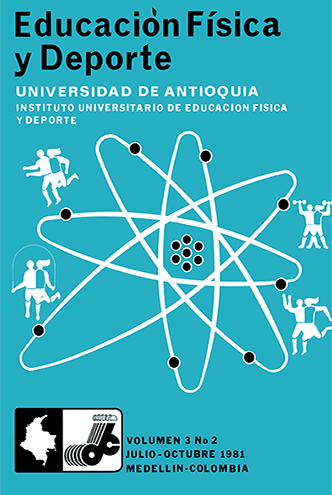POTENCIA ANAERÓBICA ALÁCTICA EN MUJERES JÓVENES CON DIFERENTES NIVELES DE ACTIVIDAD FÍSICA
DOI:
https://doi.org/10.17533/udea.efyd.22835Resumo
Los objetivos del presente trabajo fueron establecer valores medios de Potencia Anaeróbica Aláctica (P.A.A.) en mujeres jóvenes, determinar si existía diferencia significativa entre los valores de P.A.A. en los grupos con varios niveles de entrenamiento y compararlos con valores previamente reportados en hombres. La P.A.A. fue determinada en 62 jóvenes voluntarias de 17 y 21 años de edad. La población fue dividida en tres grupos de acuerdo al nivel de actividad física. Grupo I: 22 jóvenes sedentarias, sin actividad físicodeportiva regular. Grupo II : 20 estudiantes de educación física, con actividad fisico-deportiva regular pero no competitiva. Grupo III : 19 velocistas con actividad físico-deportiva regular competitiva. La P.A A. fue estimada con el método descrito por Margaria.
Downloads
Referências
1. ASTRAND, P.O. and K. RODAHL. Textbook of work physiology. McGraw-Hill Book Co., New York, 1977.
2. AYALON, A., O. INBAR andO. BAR-OR. Relationships among measurement of explo· sive strenght and anaerobic power. In: Nel· son, R. C. and C.A. Morehouse (ed.): Bio· mechanics IV, University Park Press, Balti· more,1974.
3. CERRETELI, P. Metabolismo energético . In: Pini, M.C. (ed.): Fisiología Esportiva. Guanabara Koogan, Río de Janeiro, 1978.
4. COSTIL, D. L., W.M. HOFFMANN, F. HE· HORE, S. J. MILLER and W.C. MEYERS. Maximun anaerobic power arnong coliege football players. J. Sports Med. 8: 103·106, 1968.
5. DAL MONTE. A. Avaliac;ao funcional do atleta. In: Pini, M.C. (ed.): Fisiología Espor· tiva. Guanabara Koogan, Río de Janeiro, 1978.
6. DAL MONTE, A. et L.M. Nouveau methode pour l'evaluation de la puissance anaerobic maximale alactacide. Med. Esparte, 4(1·2}: 7-11,1976/77 .
7. ERIKSON, B., P. GOLLNICK and B. SAL· TIN. Muscle metabolism and enzyme acti· vities after training ifl boys 11·1 3 year old. Acta Phys. Scand. 87: 485·497, 1973.
8. FOX, E. L. Sports Physiology, W.B. Saunders Company, Philadelphia, 1979.
9. GOLLNICK, P., R. ARMSTRONG, B. SALTIN, C. SAUBERTIV. W. SEMBROWICH and R. SHEPHE RD. Effect of training on enzyme activity and fiber composition of human skeletal muscle. J. Appl. Phys. 34(1): 107-111,1973.
10. HEGEDUS, J. Teoría general y especial del entrenamiento deportivo. Ed. Stadium, Bue· nos Aires, 1977.
11. HERMANSEN, L. Anaerobic energy release. Med. Science Sport, 1(1): 32-38,1969.
12. KARLSSON, J., L. NORDESJO, L. JOR· FELDT and B. SALTIN. Muscle lactate, ATP and CP levels during exercise after physical training in man. J. Appl. Phys. 33(2): 199·203, 1972.
13. KOMI, P., H. RUSKO, J. VOS and V. BIHkó.'l'-' Anaerobic performance capacity in athletes. Acta Phys. Scand., 100: 107·114,1977.
14. MARGARIA, R., P. AGHEMO and E. ROVELU. Measurement of muscular power (anaerobic) in man. J. Appl. Phys., 21 (5): 1662·1664, 1966.
15. MATHEWS, W.K. and E.L. FOX. Bases fi· siológicas de educac;ao física e dos desportos. Interamericana, Rio de Janeiro, 1979.
16. MATSUDO, V.K.R. Avaliac;ao de potencia anaeróbica: test de corrida de 40 segundos. Rev. Bras. Ciencias do Esparte, 1(1): 8-16, 1979.
17. MENDEZ, J. Determinacao da capacidade anaeróbica. Med. Esparte, 2(3): 127-133, Porto Alegre, 1975.
18. PINI M.C. A mulher no esparte. In:Pini, M.C. (ed .}: Fisiología Esportiva. Guanabara Koogan, Río de Janeiro, 1978.
19. RIBEIRO, J.P., A.A. LUZARDO, R.D. PETERSEN e E.H. DE ROSE. Potencia anaeró- bica alática em individuos treinados e nao treinados. Rev. Bras. Ciencias do Esparte, 1(3): ll-15, 1980.
20. RUSKO, II., V. VINKO and P. KOMI. Seaso· na! and annual changes in physical performance capacity of elite athlete. Department of Biology os Physical Activity. University of Jyvaskyla, No. 12, Finland, 1976.
21. RUSKO, H., A. ARSTILA and Y. HIRSIMAKI. Aerobic and anaerobic performance capacity of junior athletes. Department of Biology of Physical Activity. University of Jyvaskyla, No. 11, Finland, 1976.
22. SESSA, M., C.R. DUARTE e A.M.P. ALMEIDA. Teste de impulsao vertical, horizontal e de velocidade em escolares. Med. Esparte, 3(4): 163-169,1978.
23. SHA VER, L. G. Maximum anaerobic power and anaerobic work capacity measurement from various running performances of untrai· ned college men. J. Sports Med. 15:147·150, 1975.
24. THORSTENSSON, A., B. SJODIN and J. KARLSSON. Enzyme activities and muscle strength after "sprint training" in man. Acta Phys. Scand., 94: 313-318, 1975.
25. WINTHERS, R.T., R.G. ROBERTS and G.J. Med.17: 391·400, 1977. DAVIES. The max:imum aerobic power, anae· rib power and body composition of south australian male representatives in athletics bas· ketball field hockey and soccer. J. Sports
26. WURCH, T. La femme et le sport. Médicine du Sport, 2: 25-28, 1973.











